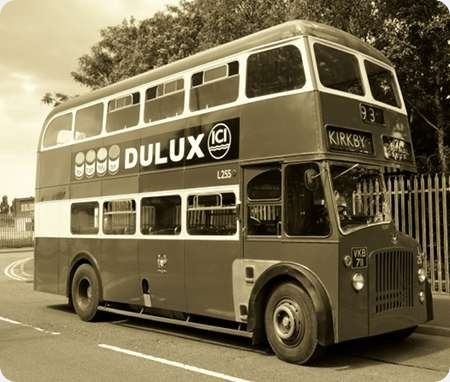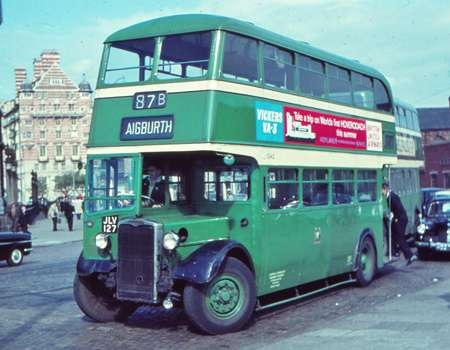Liverpool City Transport – Leyland Titan – VKB 711 – L255
Liverpool City Transport
1956
Leyland Titan PD2/20
Crossley H33/29R
New in November 1956, L255 was one of a batch of 65 Leyland Titan PD2/20 chassis that had been ordered back in 1955, partly to enable the 19 & 44 tram routes to be converted to bus operation. It was originally painted in the Dark green livery with two cream bands.
When new L255 was allocated to Carnegie Road garage, but its stay there was only short lived as it was transferred to Walton in March 1957. There it was used on routes such as 19/44/92/93 serving the new expanding housing estates of Kirkby, Southdene and Tower Hill as well as the Corporations own Kirkby Industrial Estate. where it lives today!
When Walton closed for rebuilding in October 1962, L255, along with the majority of Waltons allocation moved to the new Gillmoss garage . Following overhauls in 1966 and 1971 it returned to Gillmoss.
It then moved to Litherland garage in August 1973 and saw use on services 28,51,52,53,55,55A,56,57,57A,58,59 to Ford, Netherton and Sefton. L255’s stay at Litherland was a short one as it was transferred for the last time in April 1975 to Green Lane. There it was used mainly on peak hour extras and industrial workings until it was finally withdrawn from service in March 1976.
Purchased for preservation in May 1976 and joined the other vehicles in the growing Mersey and Calder Preservation group in 1977. As L255 was in basically good condition it was soon rubbed down and painted back into the early 1960’s livery of green with cream staircase panel and window surrounds.
In 1996 after more than 20 years in active preservation and with more than 25 years since a major overhaul, it was time for some major body restoration. After stripping every external panel off the bus, it was soon found that there was a fair amount of work involved.
Following a flurry of activity in early 2007, L255 was eventually completed finally passing the MOT 2 days before the Mersey Transport Trust’s annual running day in September 2007, proving a popular attraction during the day. During 2009 a rechromed drivers window surround was fitted and in 2010 side adverts were added much improving its appearance. It is seen at the 2014 Kirkby running day.
Photograph and Copy contributed by Ken Jones
28/10/14 – 07:03
I always thought that the Liverpool bonnet assembly detracted from the overall look of these buses. The flush windscreen and unusual livery application didn’t really help either
Chris Hough
29/10/14 – 07:12
Totally agree Chris. Much better looking examples of what was a PRV design were operated in the North West by Oldham and Stockport.
Phil Blinkhorn
29/10/14 – 15:59
When compared to other tin fronts of the period, the front panel and the area around the windscreen, give it a sort of DIY in-house accident repair appearance, rather than one that was built that way in the first place.
Ronnie Hoye
30/10/14 – 07:16
There is a lot of confusion about Crossley bodies of this period. Despite employing the PRV rear emergency window, I don’t believe this was the PRV design (as supplied later to Stockport and Oldham), and neither does the Crossley book (Eyre Heaps & Townsin). Mind you, that book isn’t foolproof; identical bodies supplied to Darwen are coded as the PRV design, while those supplied to Sunderland are coded as a Liverpool design.
The flat front to the upper deck is something specifically requested by Liverpool and used on Crossley bodies elsewhere. The standard Midland Red assembly would not have allowed this, and in fact later Liverpool bodies with the Midland Red assembly had bow-fronted bodies by Duple and Alexander.
Peter Williamson
31/10/14 – 06:27
As the owner of the bus, I can confirm that the Crossley body is of Park Royal design, I have restored both L255 & Park Royal bodied Barrow 170 CEO 957, the only difference being the window frames. Liverpool using glass mounted from the inside with a window ledge inside as against the Standard Park Royal body on 170 with windows mounted from the outside with a ledge outside. The last true Crossley designed body supplied to Liverpool was L224, L225 to L244 also carried Crossley framework but the coachwork was completed by LCPT at Edge lane works.
I hope this clarifies it more.
Rob Wilson
03/11/14 – 06:34
Thanks for your clarification, Rob. It probably means I’ve been spouting rubbish on various forums for some time, thanks to believing what experts write in books. One thing that fooled me (not clear in this view but there are plenty of other photos around) was the small rectangular windows in the front bulkhead, which Crossley had used on their own-framed bodies. On other Park Royal-framed Crossley bodies the bulkhead is the standard Park Royal type with a deeply arched lower rail to the windows. Perhaps this is again due to the different glazing system used for Liverpool (and Darwen, Sunderland and Aberdeen).
Peter Williamson
03/11/14 – 10:19
A quick scan on SCT61 pages suggests that Liverpool specified that size of front bulkhead window on all their contemporary Leyland deckers be they Saunders-Roe, Duple, Alexander or Crossley bodied.
On Stockport’s Crossley bodied Leyland deckers with PRV frames the bulkhead window bottom rail does follow the line of the engine cover but it, and those on the next batch of Longwell Green bodies, is still a very narrow window (made to look even more so by the top opening vent) compared with that fitted to their later East Lancs bodied St Helens front PD2s.
Orla Nutting
03/11/14 – 16:28
Liverpool made a habit of taking framed chassis from the likes of Weymann and Crossley but then changing the profiles. There were some very odd Weymann/Liverpool bodies on Regent IIs with an upright profile which ruined the general style of the Weymann original – and I believe they also had non-Weymann upper deck tear emergency exits. Even the Met-Camm Orion Regent Vs were not standard Met-Camm. That accolade went to the the famous Nottingham PD2s famous because they were the first Nottingham PD2s.
David Oldfield
04/11/14 – 06:45
…..and of course there were the 1949 all Crossley DD42s that Sheffield acquired new as a cancelled Liverpool order. These were neither the popularly remembered Crossley outline, nor did they have the PRV framed body. These were identical to the Regent IIIs and the first Regent Vs which Liverpool took delivery of and kept hold of. Although L255 is obviously based on the PRV design, there are also elements of the earlier design around the front (especially upper deck).
David Oldfield
05/11/14 – 06:40
Hopefully a rather extensive restoration of Barrow 170 will be completed soon by the Barrow Transport group.
So I hope that when it ventures to our NWVRT Open day at Kirkby (plug 31/5/2015)we can get them parked together to record similarities.
Another Park Royal trait that L255 carries internally is the pressed out lighting mounts along the cove panels in the upper saloon ,just like the ones on 170 & Park Royal bodied Liverpool E1.
The Crossley Bodies AEC’s and the Liverpool PD2’s up to L224 had their lights at the edge of the ceiling . Was this a standard Crossley practice ?
Rob Wilson
11/11/14 – 18:20
I now have to eat some more of my words. Earlier I said that use of the standard Leyland (originally Midland Red) bonnet assembly would not have allowed Liverpool to have their much-loved flat-fronted upper deck. I got this idea from Alan Townsin’s Duple book, which says that the uncharacteristic bow fronts of the Duple bodies on L91-140 were dictated by the design of the Leyland tin-front.
However, I now find that Darwen’s pair of Crossley-bodied PD2/20s managed to incorporate both the Leyland tin front and the Liverpool-style flat-fronted upper deck perfectly well – see www.sct61.org.uk/dw15
I also think I have solved the conundrum of the bulkhead window. Other photos of L255 show it to have a much wider bulkhead window than the Crossley-framed bodies, and the reason for departing from the standard PRV window was almost certainly the rearward-facing seat behind the bulkhead, which I had forgotten about. I have reverted to my earlier belief that other Crossley bodies with the narrow window (Darwen, Sunderland, Aberdeen) were Crossley-framed.
Peter Williamson
04/06/16 – 07:07
I thought I had a photo of a Liverpool Crossley DD42 and have now found it. C642 taken at Pier Head on July 5, 1962, still in cream bands livery and by this time only appearing on school, university and short workings.
Geoff Pullin
08/01/21 – 07:33
I loved the batch of Leylands that replaced the trams.
When I became a bus spotter circa 1962, the fleet still had remnants of pre war buses when it was difficult to buy one.
When Leyland Atlanteans were used on my school route 61 to Aigburth, occasionally in the peak hours you would get a 1947/8 Leyland Titan PD2/1 (L425-428) with Leyland coachwork with moquette seats, very harsh with short kegs (trousers). They were almost posh for their time and its such a shame that none of them were saved.
I believe L316-318 were not painted as A40. Shame they were not saved as well.
I used to go to the Edge Lane depot and walk around the withdrawals, Daimlers, early AEC regent IIIs (grim). Those lovely enamelled AEC badges on the radiators and bell pushes……
I was only 11.
Muckel Price
Quick links to the - Comments Page - Contact Page - Home Page
Comments - Please note: The comments facility is not currently available. Please see the home page for updates.
Please Note if you want to send a photograph with your comment please use the Contact Page by clicking here or send as an attachment via email.


